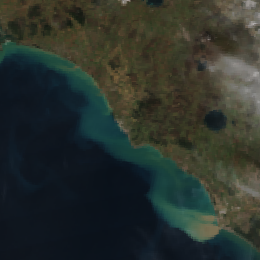cyan
Water rich in suspended matter or shallow with sediments on its bottom appears greenish or blueish cyan in the VIIRS True Colour RGB images. It may appear also brownish.
The image below shows an example. The water of the Adriatic Sea has a very different colour along the Italian coast. Here the water is shallow, the coast is mostly sandy and the rivers bring sediment into the sea.
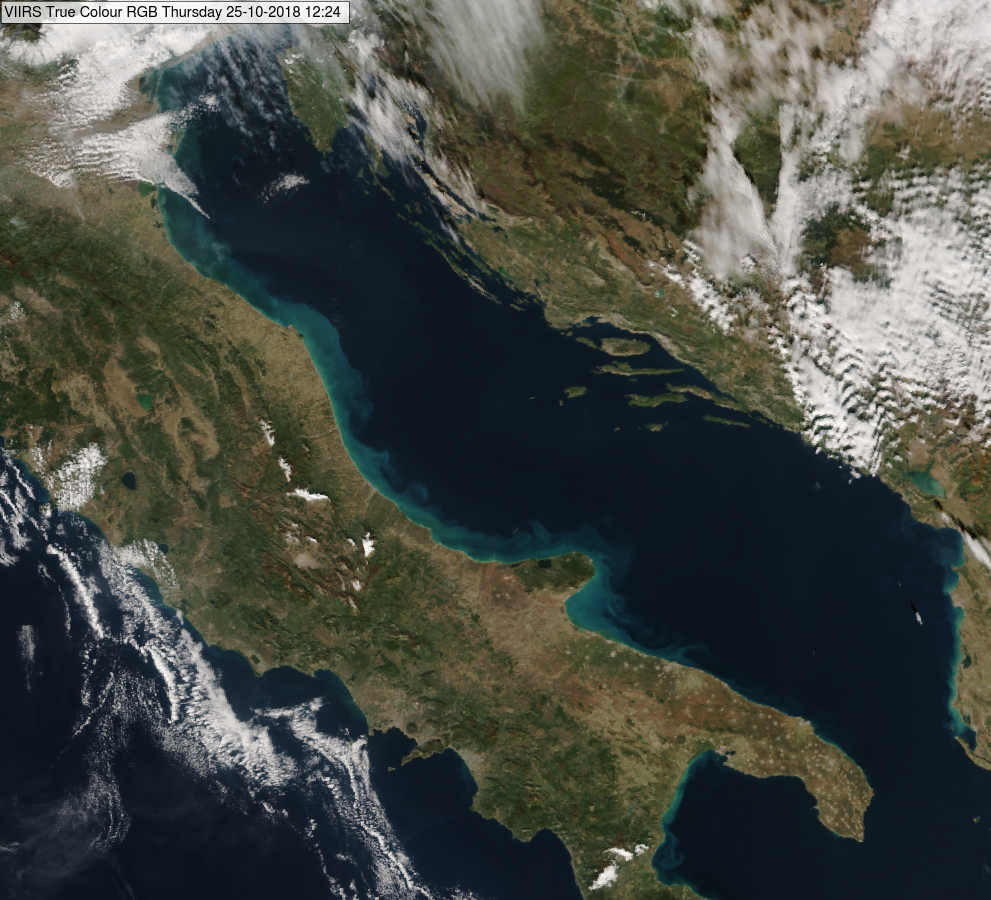
NPP, VIIRS True Colour RGB image for 25 October 2018, 12:24 UTC
The Hungarian Lake Balaton and the Lake Neusiedl on the Austrian Hungarian border are shallow and their bottom is sandy/silty. They appear greenish cyan in the following image.
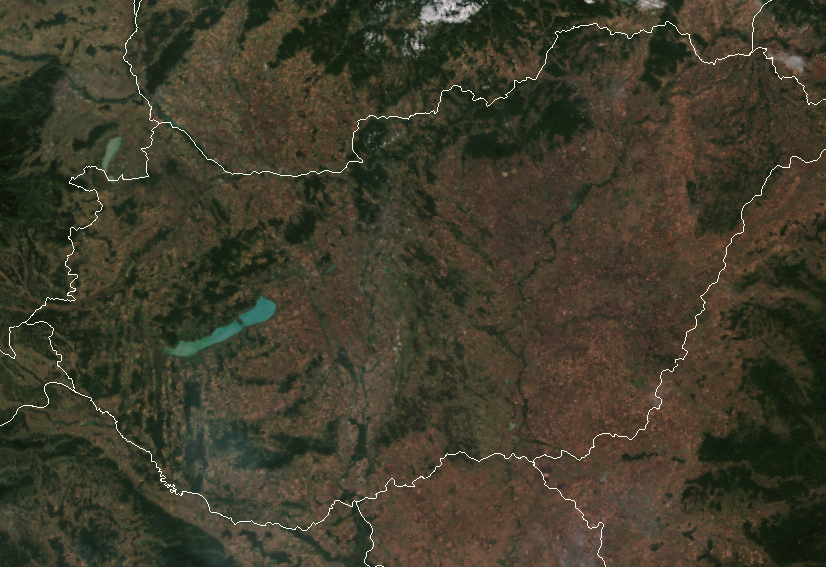
NPP, VIIRS True Colour RGB image for 28 September 2018, 10:49 UTC
The next image shows the shallow Sea of Azov and the much deeper Black Sea.
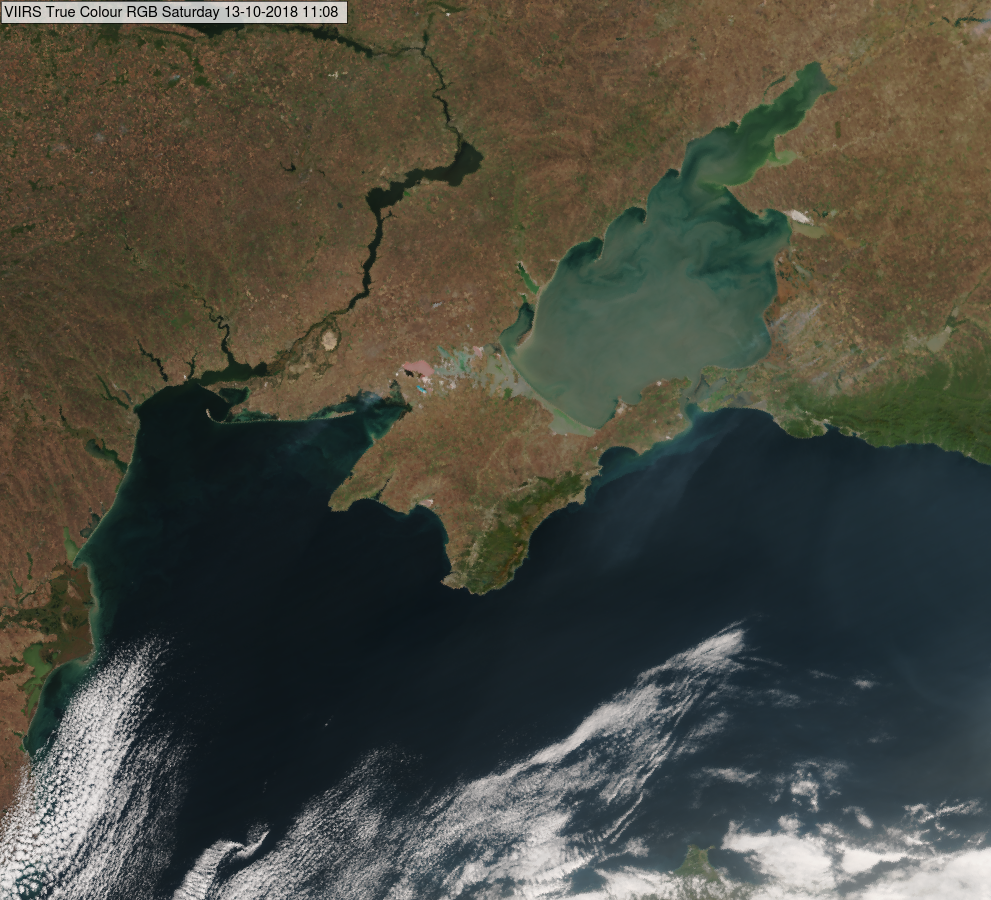
NPP, VIIRS True Colour RGB image for 13 October 2018, 11:08 UTC
The next image shows the region of the Gironde estuary in France. The Garonne river transports sediment into the Atlantic Ocean.
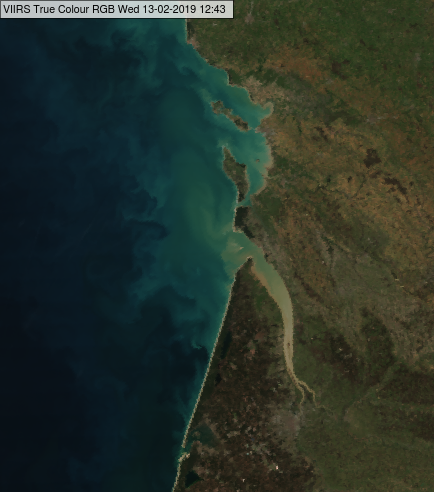
NPP, VIIRS True Colour RGB image for 13 February 2019, 12:43 UTC
The next 2 images show sediment plumes around Mississippi river delta and in East China Sea.
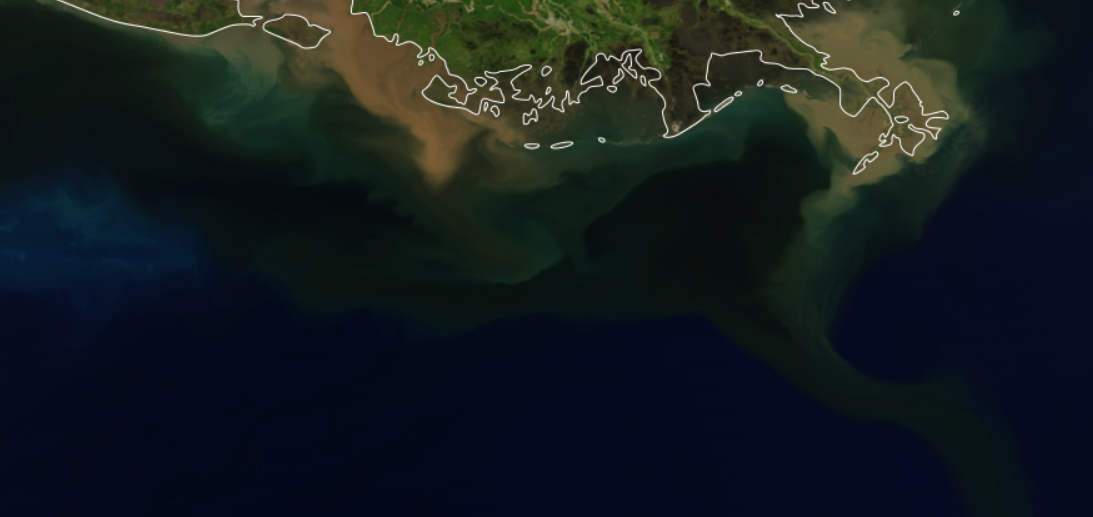
NOAA-20, VIIRS True Colour RGB image for 17 April 2018
(Source: https://www.star.nesdis.noaa.gov/sod/mecb/color/
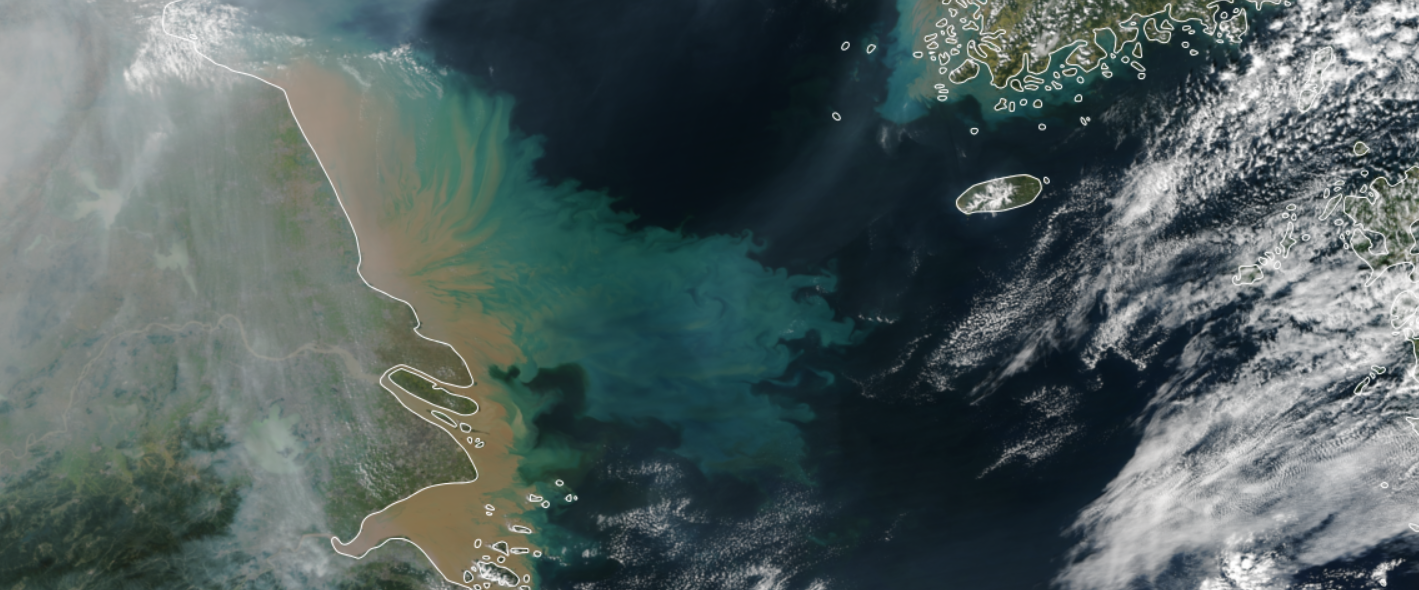
NPP, VIIRS True Colour RGB image for 15 October 2015
(Source: https://www.star.nesdis.noaa.gov/sod/mecb/color/
Phytoplankton is a microscopic organisms that live in watery environments. When conditions are right, phytoplankton undergo explosive population growth, creating blooms visible in True Colour RGB images. The next image shows an algae bloom example in in Gulf of Mexico.
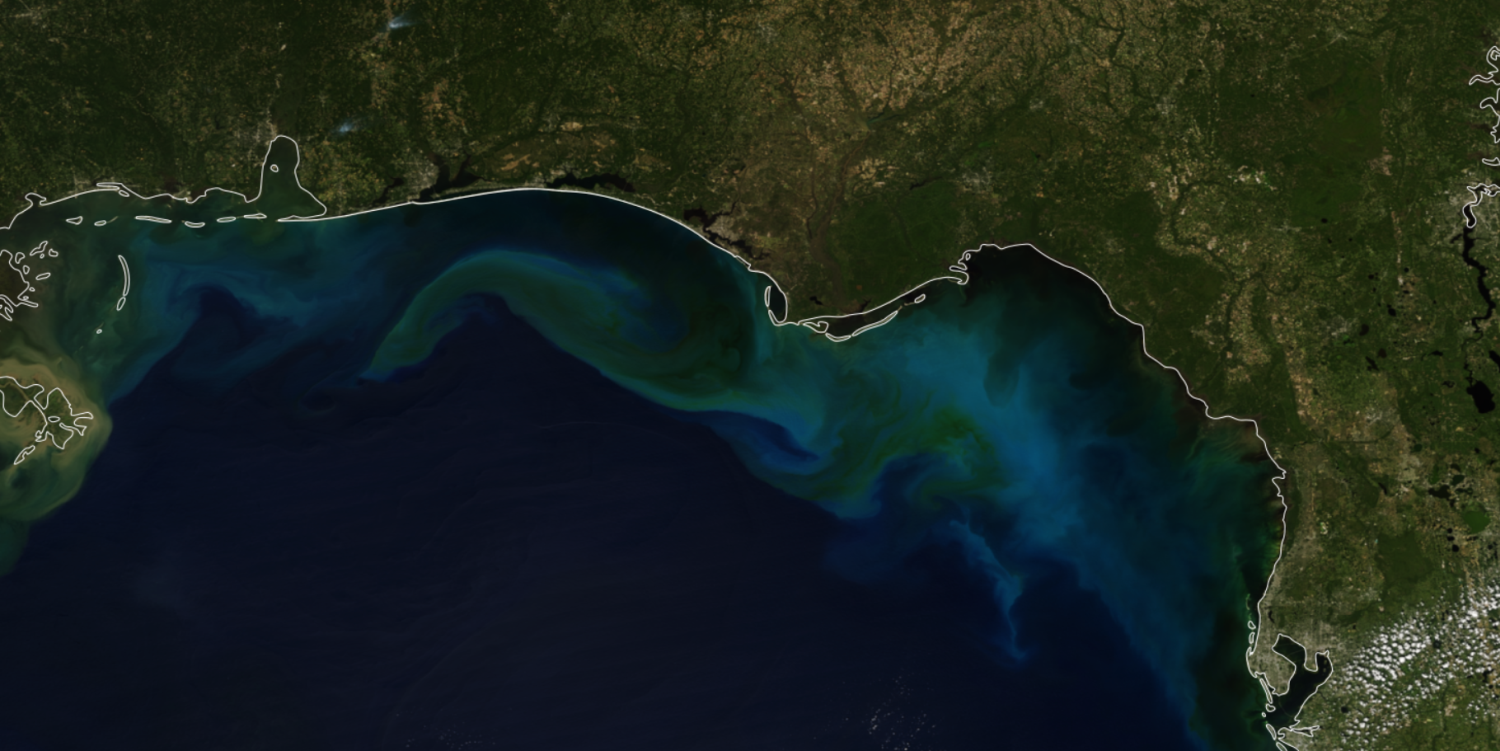
NOAA-20, VIIRS True Colour RGB image for 13 October 2018
(Source: https://www.star.nesdis.noaa.gov/sod/mecb/color/
Note that:
• The water reflectivity depends not only on the water characteristics but as well as on the solar and satellite viewing directions. Towards the edge of the swath the colour shades may be brighter, while along the sub-satellite track it might be slightly darker.
• Deep, clean water bodies appear dark blue, almost black in the True Colour RGB, see examples separately.
• If there is high concentration aerosol plume above the sea (such as lofted dust, smoke) the colour of the sea trough the aerosol layer modifies.
• Sea ice appears whitish.
Explanation of the colour of suspended matter rich water in the True Colour RGB (see the recipe):
The reflectivity of deep, clean water is very low in all three visible channels, so the deep, clean water bodies appear dark blue, almost black in the True Colour RGB.
In case of suspended matter, the reflectivity values increase. The resulting colour depends on the type and concentration of the sediments.
Warm, thin dust (sand) clouds over cold surfaces depict in cyan in the Night Microphysics RGB images.
Warm sand is blown in low-levels from Libyan desert by strong winds over the cold Mediterranean Sea (left image).
This colour is rare for thin dust clouds because they usually appear in pink tones. In the left image, one can see higher level dust clouds in pink and low-level dust clouds in cyan colour. The thin low-level dust cloud is cyan instead of pinkish because of the strong temperature inversion.
Under 'normal' conditions, i.e. warm surface and colder dust cloud, the BT difference (IR12.0 - IR10.8) of the red colour beam would be positive and dominate the colour of the dust cloud. But due to the temperature inversion (cold sea and warm dust) and the relatively thin dust cloud, the red component is negative (~ -3 K) hence contributing only negligibly to the colour of the dust cloud. If the dust cloud were thicker, the difference would be around 0 K and contribute more to the red colour beam.
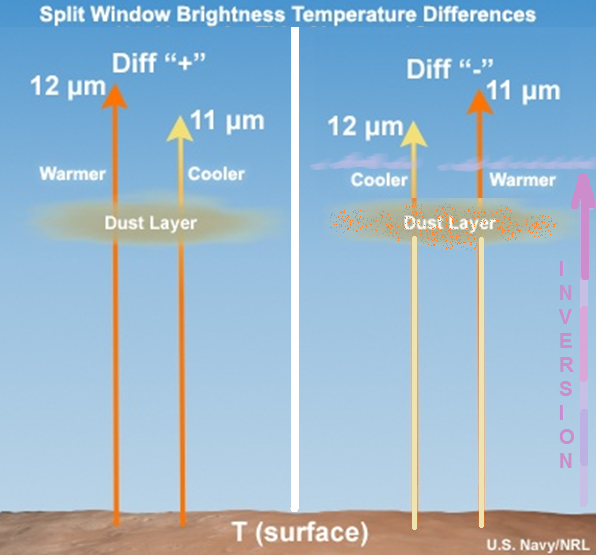
The surface is warmer than the dust cloud ----------- The surface is colder than the dust cloud
The green colour beam (IR10.8 - IR3.9) is strongly contributing (stronger than for thick dust clouds) because thin dust clouds are more transparent at IR3.9 than at IR10.8. In case of an inversion (dust cloud warmer than surface) this leads to large positive BTD (IR10.8 – IR3.9).
The same effect can be observed during night when dust is transported over a cold desert (see the animation below). During daytime, when solar component is added and the temperature inversion disappears, the colour changes drastically as can be seen at the end of the loop.
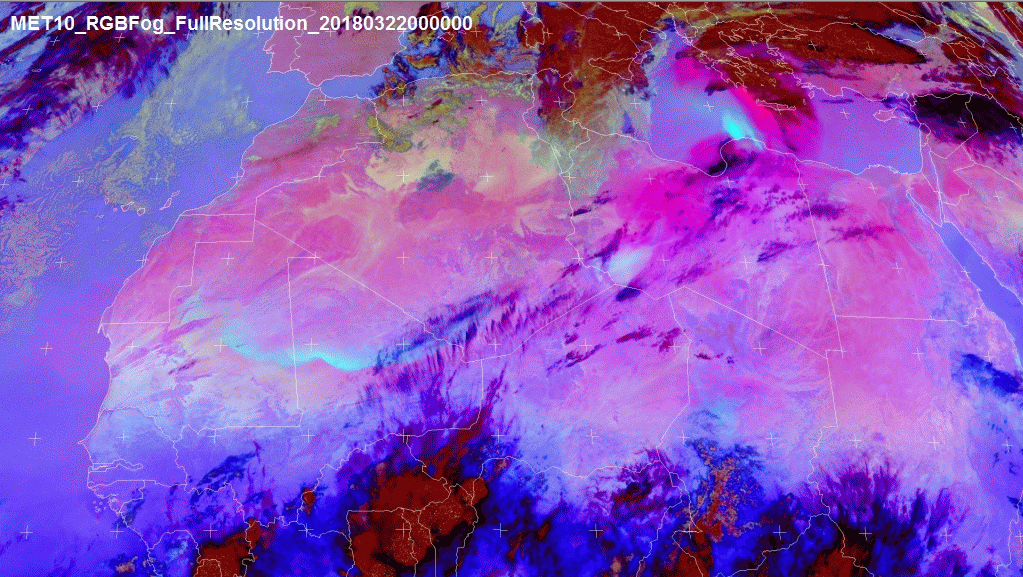
Night Microphysics RGB from 22 March 2018, 00:00 UTC
Explanation of the cyan colour of warm low-level thin dust clouds in strong temperature inversion in the Night Microphysics RGB (see the recipe):
• Dust clouds usually contribute with a strong red signal in the Night Microphysics RGB (as dust clouds are more transparent in IR12.0 than in IR10.8 channel, see the above graphic). In case of a strong temperature inversion near the ground and a thin low level dust cloud, the red signal is almost missing. Therefore the dust cloud becomes cyan (green + blue).
Sandy desert appears cyan in the Ash RGB images: aqua-cyan when the surface is hot, or light greenish cyan (aquamarine) when the surface becomes colder. In case the area is covered by a very thin dust cloud (and/or the vertically integrated water vapour content is very low) the colour becomes lighter (almost white).
The images below show the Sahara at noon and midnight. Note that a dust cloud is seen over the Arabian Peninsula.
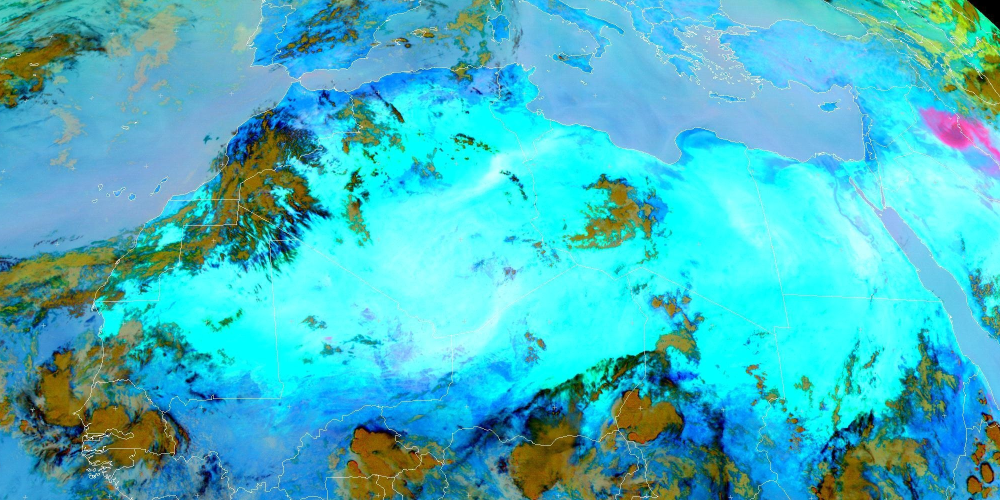
Meteosat, SEVIRI Ash RGB for 1 September 2015 12 UTC (Source: EUMETSAT, Real-time images)
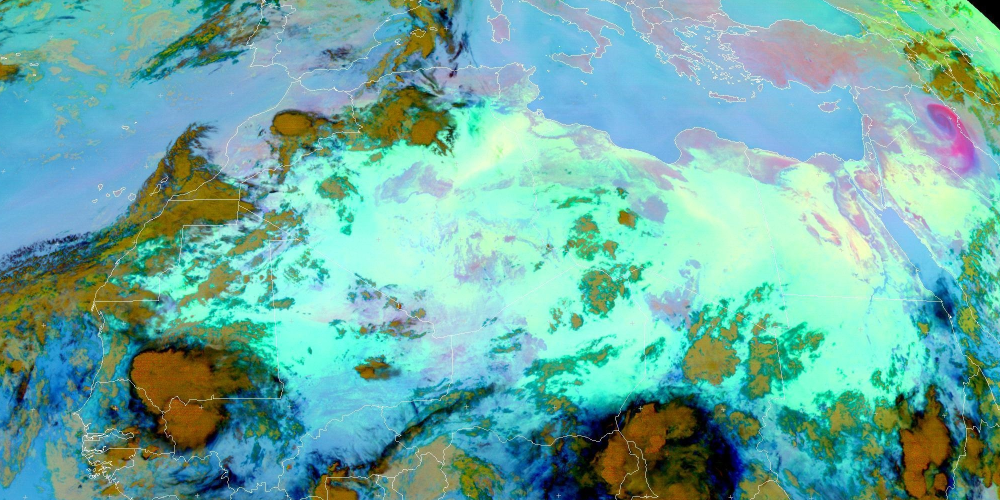
Meteosat, SEVIRI Ash RGB for 1 September 2015 00 UTC (Source: EUMETSAT, Real-time images)
Note that rocky desert appears bluish during daytime and pinkish in the night.
Explanation of the colours of sandy desert (see the recipe):
• The red signal may change from weak to strong. The (IR12.0 - IR10.8) brightness temperature difference increases if the area is covered by a very thin dust cloud (and/or the vertically integrated water vapour content is very low).
• The green signal is usually saturated. The (IR10.8 - IR8.7) brightness temperature difference is high for sand, because the emissivity of sand is much lower in the 8.7 than in the 10.8 micrometer channel. The difference is usually higher than the upper limit of the corresponding range (see the recipe on the left).
• The IR10.8 brightness temperature depends on the surface temperature, which has a strong daily cycle. The blue signal is strong/saturated during daytime. During nighttime it is medium strong or higher, but not saturated.
As a consequence the hot sandy desert appears cyan, while in the night the colour tends towards aquamarine (light greenish cyan). In case the area is covered by a very thin dust cloud (and/or the vertically integrated water vapour content is very low) the colour becomes lighter (almost white).
Thick ice clouds appear cyan in the HRV Fog RGB images.
The images left and below show frontal cloudiness and deep convective cloud. Note that although thick ice clouds show similar colour as the snow covered land, the colour is not exactly the same. Thick ice clouds appear slightly lighter cyan, with some greyish tones. In our examples snow covered land is seen for example in Scandinavia, the Alps, Carpathian Mountains, Sweden, Dinaric Alps.
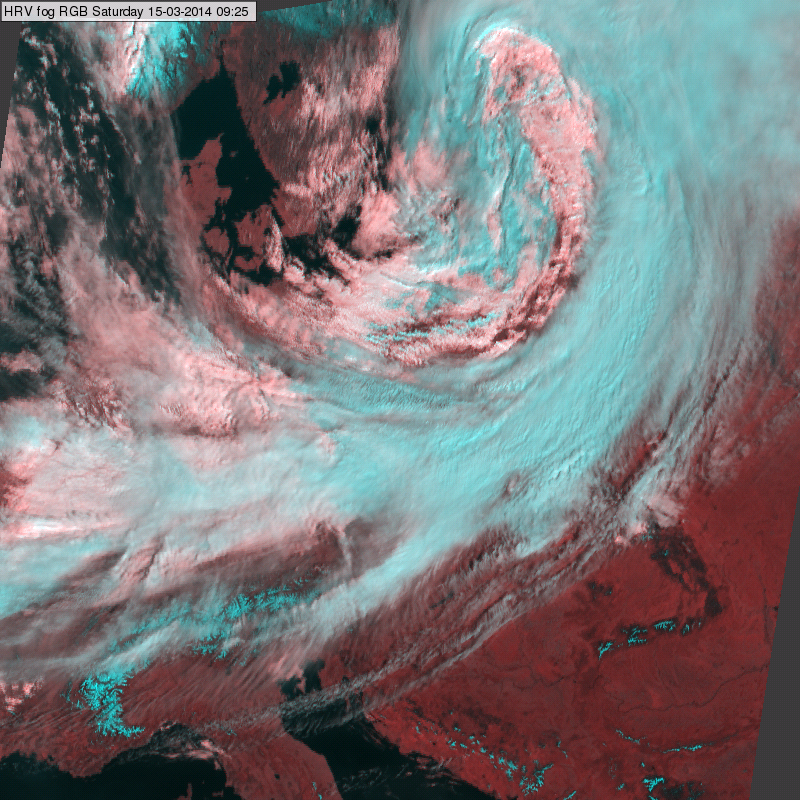
Meteosat, SEVIRI HRV Fog RGB for 15 March 2014, 09:25 UTC

Meteosat, SEVIRI HRV Fog RGB for 13 February 2014 11: 40 UTC (left) and 08 November 2008 07:55 UTC (right)
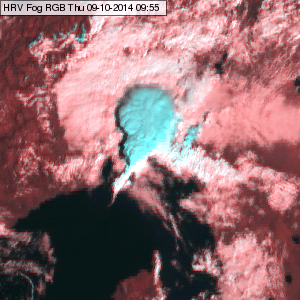
Meteosat, SEVIRI HRV Fog RGB for 9 October 2014, 09:55 UTC
Explanation of the colours of thick ice clouds (see the recipe):
• Thick ice clouds have low reflectivity in the 1.6 micrometer channel, because ice particles absorb the radiation at these wavelengths. After the linear stretching in the 0-70 % reflectivity interval the red colour beam signal becomes medium strong.
• Thick ice clouds have high reflectivity in the HRV channel, resulting strong signals in the green and blue colour beams.
As a consequence thick ice clouds appear cyan with some gray tones in the HRV Fog RGB images: high and equal signals in the green and blue colour beams and medium signal in the red colour beam.
As the 1.6 micrometer reflectivity of the thick ice cloud is usually higher than for snow covered land, the red component is slightly stronger for thick ice clouds than for snow covered land. That is why the thick ice clouds appear slightly lighter cyan with some grey tones.
Snow appears cyan in the HRV Fog RGB images.
The image left and the two images below show several snow covered European Mountains. The snow on the high mountains shows usually brighter cyan colour, than on the mainland or on the hills, as the snow cover is less disrupted by vegetation. One can often see the typical structure of the valleys, ridges.

Meteosat, SEVIRI HRV Fog RGB for 13 March 2014, 11:40 UTC
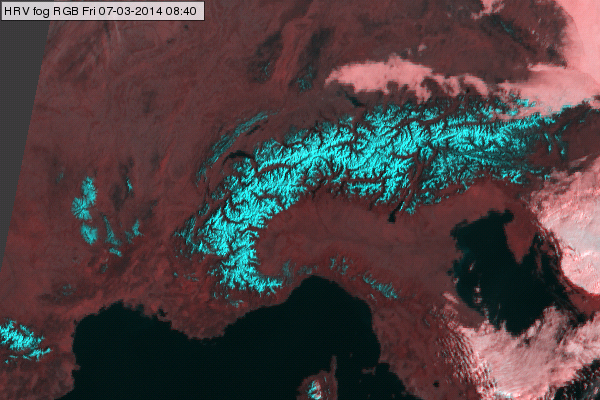
Meteosat, SEVIRI HRV Fog RGB for 7 March 2014, 08:40 UTC
The following image shows snow covered mainlands, low hills (with clouds in some areas). In the less bright cyan colour one can see patches, spots, lines. Patches might be due to forest with shadows and branches not covered by snow. Lines might be due to rivers, spots (small patches) due to settlements.
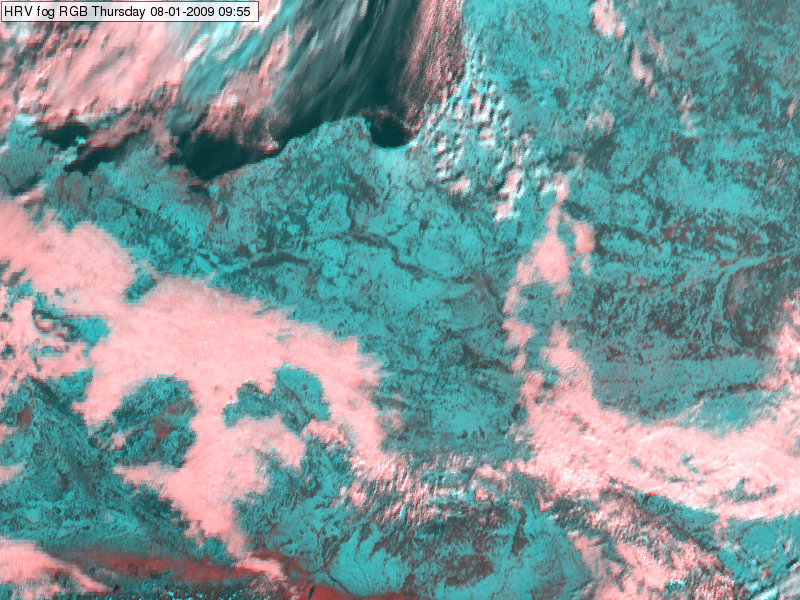
Meteosat, SEVIRI HRV Fog RGB for 8 January 2009, 09:55 UTC
Explanation of the colours of snow in the NRV fog RGB (see the recipe):
• Snow has low reflectivity in the 1.6 micrometer channel. The signal in the red colour beam will be low (less than medium) even after the linear stretching in the 0-70 % reflectivity interval.
• Snow has high reflectivity in the HRV channel, resulting strong signals in the green and blue colour beams.
As a consequence snow appears cyan in the HRV Fog RGB images: high and equal signals in the green and blue colour beams and much weaker signal in the red colour beam.
Sandy desert appears cyan in the Day Microphysics RGB because of the following reasons. The reflectivity of sand in the 0.87 micron channel is medium strong, resulting in a moderate signal in the red colour beam. The reflectivity of sand in the 1.6 micron channel is much higher, resulting in a very high (often saturated) signal of the green colour beam. The temperature of the desert surface during daytime is very hot, causing a strong signal in blue colour beam as well. So the mixed colour for the daytime sandy desert will be cyan (medium red, intense green and blue). See the recipe.
The images below show the Sahara on 04 September 2014. Note, that the bluish patches within the Sahara desert are the areas not covered with deep sand, but rocky fields, rocky vegetationless mountains, or vegetation along the Nile.
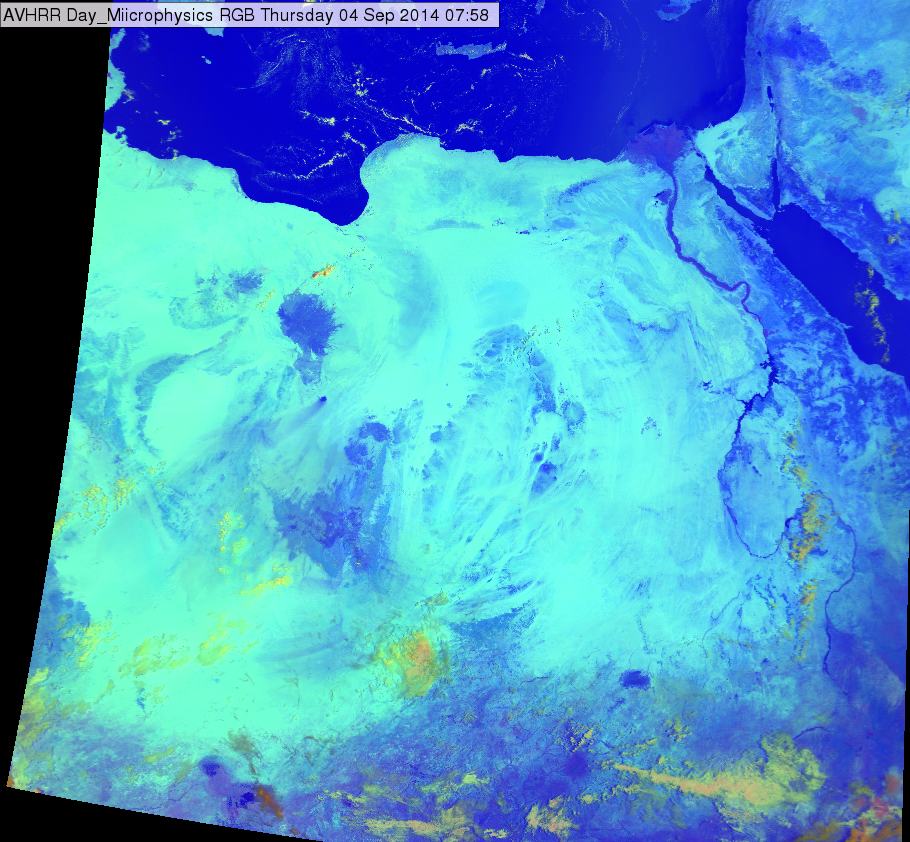
MetOp AVHRR Day Microphysics RGB image, 04 September 2014 07:58 UTC
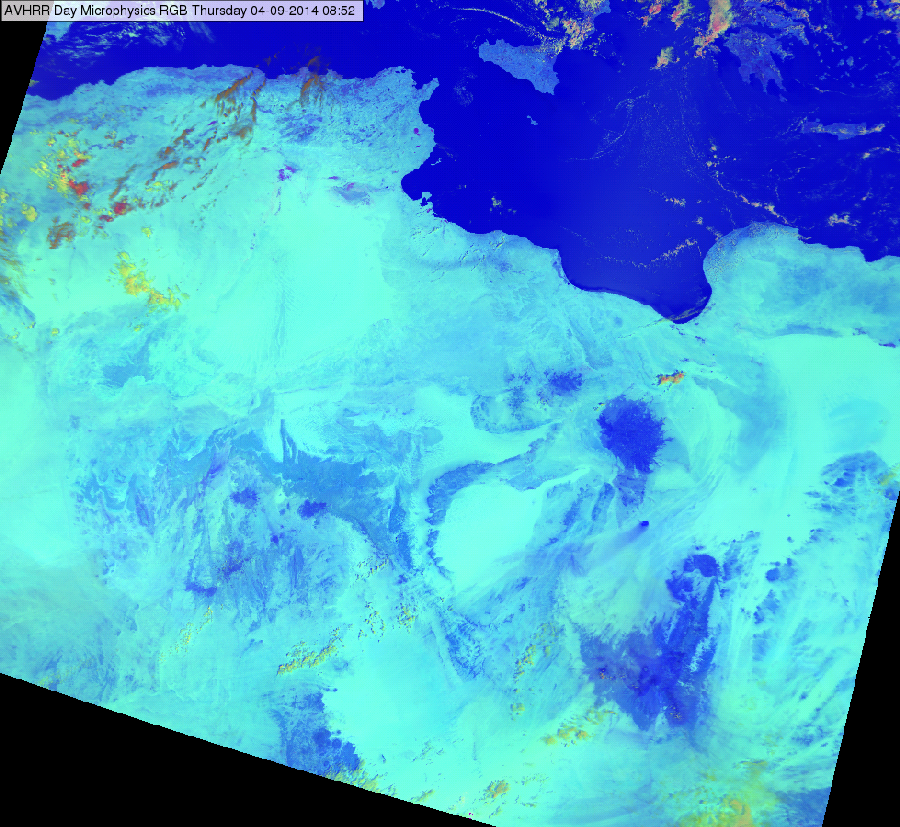
MetOp AVHRR Day Microphysics RGB image, 04 September 2014 08:52 UTC
The Natural Colour RGBs are created from three channels all measuring reflected solar radiation. Ice clouds are usually seen in these RGBs because they reflect the shortwave radiation. Ice clouds are depicted in cyan colour, since ice crystals absorb more radiation in the 1.6 micron channel than in the 0.63 and 0.87 channels, and so the channels 1 and 2 contribute much more to the satellite measured radiation than channel 3A. The MetOp AVHRR Natural Colour RGB image below shows stratiform thin cirrus clouds (taken on 14 March 2014 at 09:41 UTC).
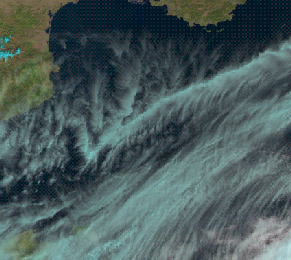
MetOp AVHRR Natural Colour RGB image, 14 March 2014 09:41 UTC
Cirrus clouds are high level clouds consisting mainly from ice crystals. They can have various structures, and they typically consist of thicker and thinner parts. Thin cirrus clouds are semi-transparent letting some radiation coming through from below. Through the semi-transparent regions one can recognize the underlying surface/clouds ‘blurrily’, like in the image below (taken on 25 February 2014 at 10:34 UTC).
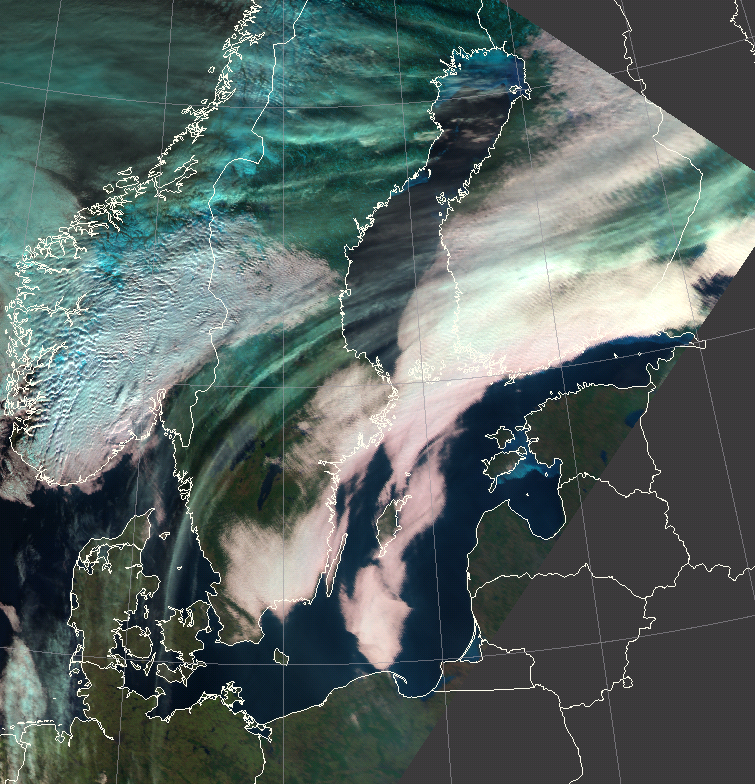
MetOp AVHRR Natural Colour RGB image, 25 February 2014 10:34 UTC
Semi-transparent clouds are easier to recognize over dark ‘background’ like sea or ocean, see the image below (taken on 11 March 2014 at 09:58 UTC). Cirrus clouds could be recognized by their colour, structure, semi-transparent nature. The thinnest clouds may not be seen because their reflection is week. They can be better detected by using infrared channel differences.
MetOp AVHRR Natural Colour RGB image, 11 March 2014 09:58 UTC
Explanation of the cyan colour for thin stratiform cirrus clouds in the Natural Colour RGB (see the recipe):
• With a strong contribution of the green and the blue colour beam over thin cirrus clouds, the resulting colour is cyan.
Ice clouds are usually seen in the Natural Colour RGB images because ice particles reflect the shortwave radiation. Ice clouds are depicted in cyan colour. Channels 1 and 2 contribute much more to the satellite measured radiation than channel 3A, because ice crystals strongly absorb in the 1.6 micron channel.
Cirrus clouds are high level clouds consisting mainly from ice crystals. They can have various structures and they typically consist of thicker and thinner parts. Thin cirrus clouds are semi-transparent letting some radiation coming through from below.
The MetOp AVHRR Natural Colour RGB image below (taken on 03 March 2014 at 06:43 UTC) shows cirrocumulus clouds. The underlying features (first of all the bright features – in the present case the snow covered mountains of Turkey and Armenia) can be seen ‘blurrily’ trough the thinner parts of the cirrocumulus cloud. Cirrus clouds could be recognized by their colour, structure and semi-transparent nature.
MetOp AVHRR image from 3 March 2014 at 06:43 UTC
Explanation of the cyan colour of cumuliform cirrus clouds in the Natural Colour RGB (see the recipe):
With a strong contribution of the green and the blue colour beam over sandy deserts, the resulting colour is cyan.
In the Natural Colour RGB images the snow covered area appears cyan or bright blue because its reflectivity is high both in the 0.87 and in the 0.63 micron channels, while much lower in the 1.6 micron channel. The 1.6 micron radiation is strongly absorbed by snow and ice crystals. The image below shows the snow covered Alps on 14 March 2014 at 08:52 UTC. Some peaks and ridges in the Apennines are also covered by snow.
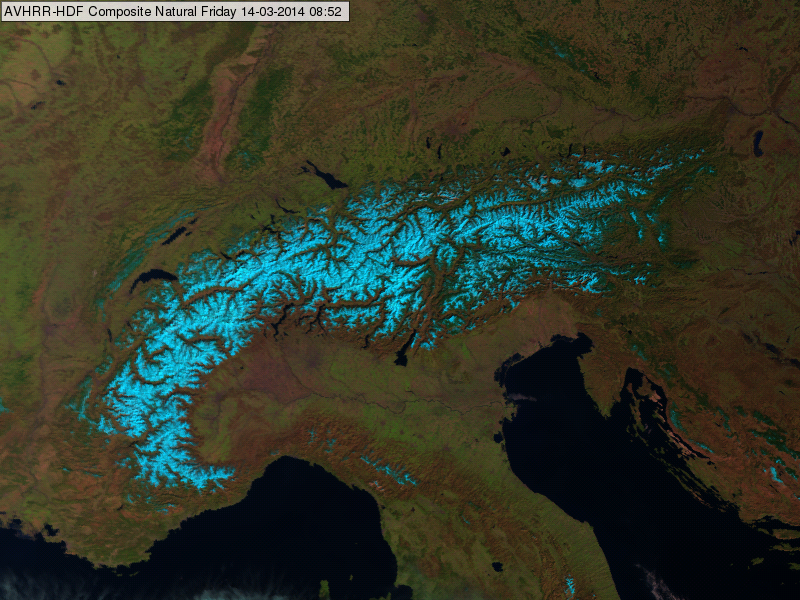
The following image shows the snow covered Pyrenees and Massif Central on 08 March 2014 at 10:06 UTC.

Explanation of the cyan colour of snow on mountains in the Natural Colour RGB (see the recipe):
With a strong contribution of the green and the blue colour beam over snow, the resulting colour is cyan.
In the Natural Colour RGB the open water areas (not covered by ice) is black or very dark blue, while the sea ice is cyan, deep cyan or pale blue. AVHRR channels 1 (0.63 micron) and 2 (0.87 micron) contribute much more than channel 3A (1.6 micron) to the satellite measured radiation since the latter is strongly absorbed by ice crystals.
The sea ice is usually darker and/or more bluish than snow, especially when it is thin and in stage of melting, defrosting. Sea ice reflects less in the visible (0.63 and 0.87) bands than fresh snow. This may have several reasons, like the irregular shape, the presence of open water areas (black), the age of the ice etc. It depends also on the viewing angles.
The image below shows the MetOp AVHRR natural colour composite from Wednesday 26 February 2014 at 06:49 UTC.
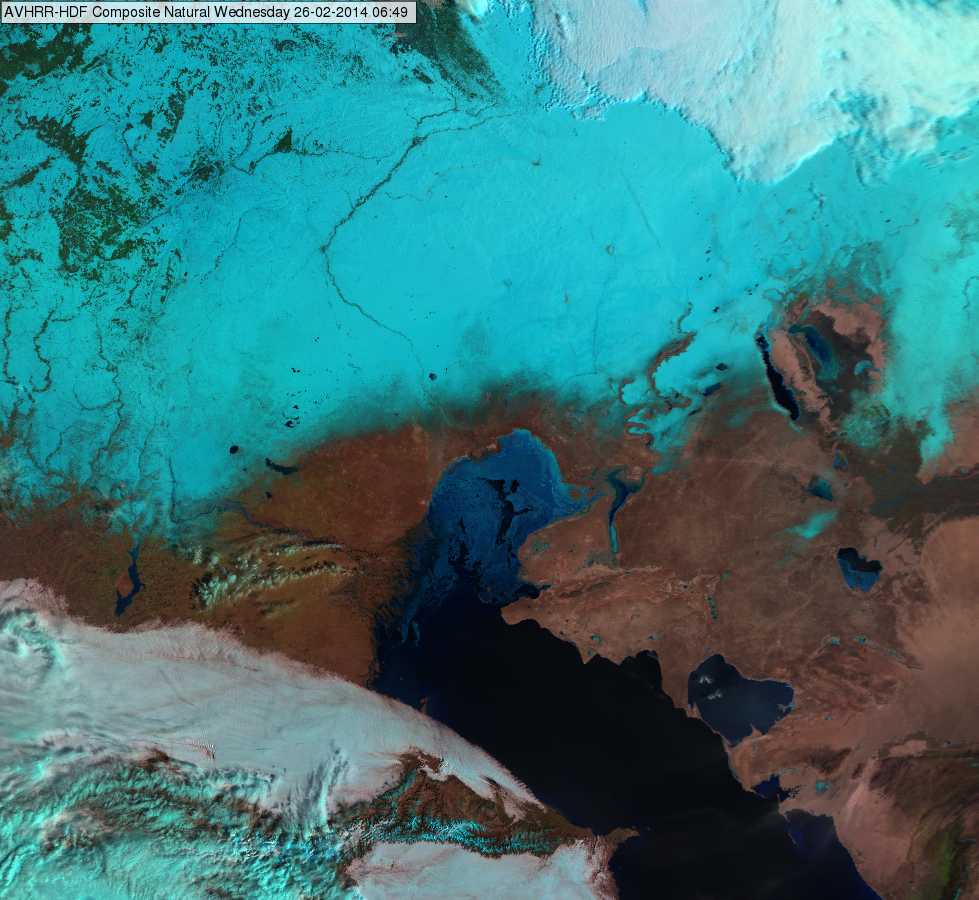
MetOp AVHRR natural colour composite ,26 February 2014 at 06:49 UTC
The Caspian Sea isn’t really a sea, but a giant salt water lake. In the winter, ice often forms over the lake’s northernmost reaches, while the central and southern parts remain ice free. Ice forms not only due to the higher latitude. The northern part is much shallower, around 10 meter or less, while the middle and southern parts are several hundred meters deep. Furthermore the water is saltiest in the south and freshest in the north, due to the fact that most of the rivers feeding the giant lake with fresh water enter from the north or west. The freezing point of the salty water is lower.
Explanation of the cyan colour of sea ice in the Natural Colour RGB (see the recipe):
With a strong contribution of the green and the blue colour beam over sea ice, the resulting colour is cyan.
Sandy deserts depict in cyan in the Day Microphysics RGB images.
The red colour beam (VIS0.8) is smaller compared to the green and blue colour contribution. The reflectivity in the VIS0.8 channel depends mainly on the sun angle.
The reflection of short wave solar radiation measured by channel IR3.9 is very high for bare soils (sandy desert). Vegetated surfaces have a small albedo at 3.9 micrometer.
The intensity of the blue colour beam increases with temperature. Sandy deserts show very high temperatures during the summer months, therefore, the blue colour contribution is very high.
With a strong contribution of the green and the blue colour beam over sandy deserts, the resulting colour is cyan. This can be seen on the below Day Microphysics RGB image which displays Egypt and the Arabian peninsula.
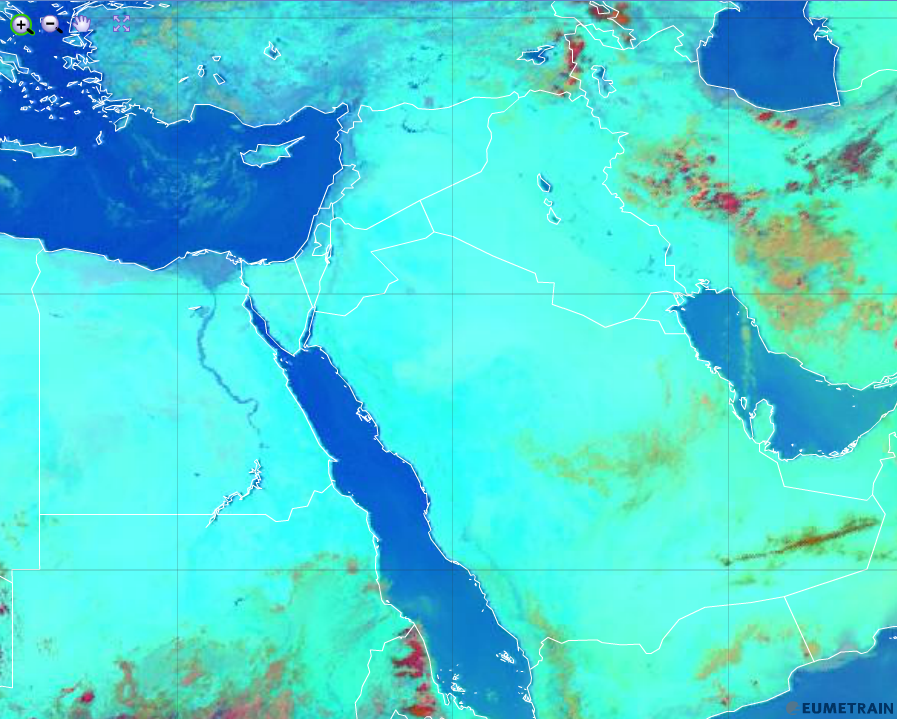
HRV Cloud RGB from 24 July 2015, 12:00 UTC
Explanation of the cyan colour of sandy deserts in the Day Microphysics RGB (see the recipe):
With a strong contribution of the green and the blue colour beam over sandy deserts, the resulting colour is cyan
Dry salt lakes
The salty ground of dry salt lakes appears as intense cyan colour in the Natural Colour RGB images.
The left hand image shows the Tuz Gölü lake in central Turkey scanned by the SEVIRI instrument. The green and blue colour beam (VIS channels 0.6 and 0.8 micrometer) contribute much more than the red colour beam of the 1.6 micron NIR channel to the satellite measured radiation. In opposition to reflection from deserts and bare grounds where the near-infrared channel contribution is very intense, the salty surface shows a similar behaviour like snow and ice (i.e. an almost complete absorption of short wave solar radiation at 1.6 micrometer).
This phenomenon is visible mainly during the summer month when water evaporates and leaves the whitish sea ground (see image below).
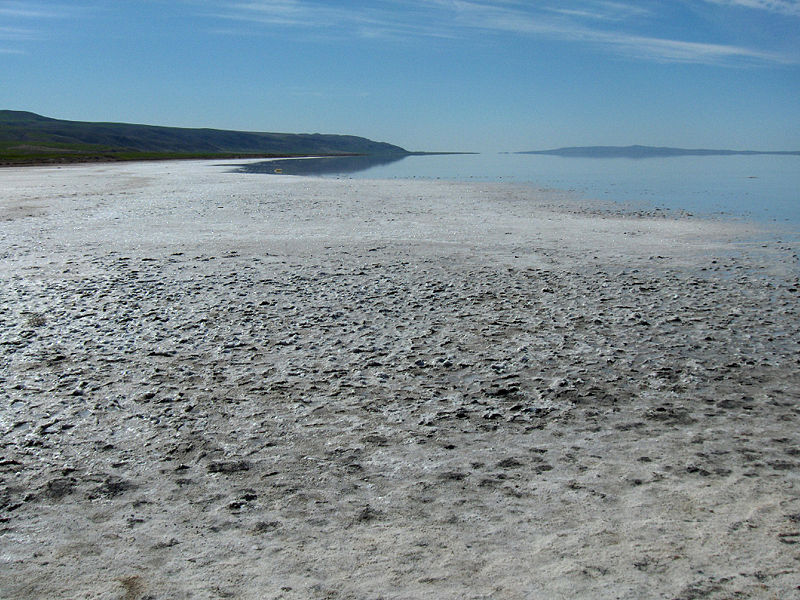
Tuz Gölü (Central Turkey)
As the AVHRR sensor onboard NOAA and MetOp polar satellites has the same spectral channels in the visible and near IR range, this feature can also be seen on their Natural Colour RGB (see image below).

MetOp-A Natural Colour RGB for 20 June 2013 08:25 UTC
Explanation of the colours of salt lakes in the Natural Colour RGB (see the recipe):
• Radiation mesured by the SEVIRI instrument of MSG in channel 1 (0.6 micron) and channel 2 (0.8 micron) contributes much more to the Natural Colour RGB than radiation measured in channel 3 (1.6 micron). Solar radiation is strongly absorbed by salt crystals at 1.6 micrometer while it is strongly reflected in both visible channels 0.6 and 0.8 micrometer. Cyan is resulting from a mixture of blue and green.

